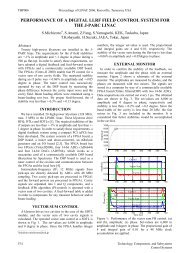Design and Development of a Diagnostics Client for a Beam Loss ...
Design and Development of a Diagnostics Client for a Beam Loss ...
Design and Development of a Diagnostics Client for a Beam Loss ...
Create successful ePaper yourself
Turn your PDF publications into a flip-book with our unique Google optimized e-Paper software.
<strong>Design</strong> <strong>and</strong> <strong>Development</strong> <strong>of</strong> a <strong>Diagnostics</strong> <strong>Client</strong> <strong>for</strong> a <strong>Beam</strong> <strong>Loss</strong> Measurement System at CERN<br />
3. HARDWARE IMPLEMENTATION<br />
After giving the general in<strong>for</strong>mation about the BLM <strong>for</strong> the Injectors project, that is going<br />
to be needed in the next sessions, we are going to describe the hardware architecture<br />
<strong>and</strong> implementation <strong>of</strong> the new BLM system. This up-to-date BLM system will be included<br />
<strong>for</strong> the monitoring <strong>of</strong> the beam losses, machine protection <strong>and</strong> is still under development<br />
in terms <strong>of</strong> hardware (Electronics) <strong>and</strong> low-level s<strong>of</strong>tware. The system is making use <strong>of</strong><br />
reprogrammable devices, i.e. Field Programmable Gate Arrays (FPGA), to allow flexibility<br />
<strong>and</strong> target all injector’s requirements. An overview <strong>of</strong> the new BLM system can be seen<br />
in Figure 2 [19].<br />
3.1 Description <strong>of</strong> the new BLM System<br />
Figure 2: Overview <strong>of</strong> the new BLM System<br />
The purpose <strong>of</strong> the new <strong>Beam</strong> <strong>Loss</strong> Monitoring System (BLM) is the beam setup <strong>and</strong> ma-<br />
chine protection <strong>of</strong> the Injector accelerators at CERN. For their upgrade to higher beam<br />
energies <strong>and</strong> intensities, this new BLM system is under development. It will focus on pro-<br />
viding faster measurement updates with higher dynamic range <strong>and</strong> the ability to accept<br />
more types <strong>of</strong> detectors as input compared to its predecessors. The detectors are con-<br />
nected to the acquisition part <strong>of</strong> the system. These detectors in the majority <strong>of</strong> the cases, is<br />
<strong>for</strong>eseen to use ionization chambers similar to those developed <strong>for</strong> the LHC. Nonetheless,<br />
several other types, such as secondary emission monitors, diamonds <strong>and</strong> Cherenkov de-<br />
tectors, may need to be used in some locations to cover particular cases. The detectors<br />
will be connected with the front-end using coaxial double-shielded cables <strong>and</strong> wherever<br />
possible, these cables will pass through enclosed cable trays, in order to make use <strong>of</strong><br />
any possible means <strong>for</strong> noise reduction. The digitization <strong>of</strong> the detectors current input will<br />
make use <strong>of</strong> a new concept, which is currently under development. The input channel<br />
circuit should be able to measure current from 10 pA to 200 mA, a dynamic range <strong>of</strong> 10 11 ,<br />
making use <strong>of</strong> two measurement methods. These methods will be explained briefly in the<br />
next chapters. The connection between the acquisition <strong>and</strong> the processing part <strong>of</strong> the<br />
Emmanouil I. Angelogiannopoulos 16















